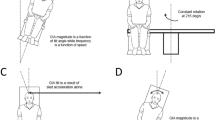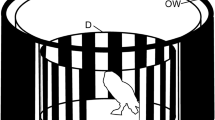Summary
Pigeons freely standing in the centre of a two-dimensionally textured cylinder not only rotate but also laterally translate their head in response to the pattern sinusoidally oscillating or unidirectionally rotating around their vertical axis. The translational head movement dominates the response at high oscillation frequencies, whereas in a unidirectionally rotating drum head translation declines at about the same rate as the rotational response increases. It is suggested that this is a consequence of charging the ‘velocity storage’ in the vestibulo-ocular system. Similar to the rotational head movement (opto-collic reflex), the translational head movement is elicited via a wide-field motion sensitive system. The underlying mechanism can be described as vector integration of movement vectors tangential to the pattern rotation. Stimulation of the frontal visual field elicits largest translational responses while rotational responses can be elicited equally well from any azimuthal position of a moving pattern. Experiments where most of the pattern is occluded by a screen and the pigeon is allowed to view the stimulus through one or two windows demonstrate a short-range inhibition and longrange excitation between movement detectors that feed into the rotational system. Furthermore, the results obtained from such types of experiments suggest that the rotational system inhibits the translational system. These mechanisms may help the pigeon to decompose image flow into its translational and rotational components. Because of their translational response to a rotational stimulus, it is concluded, however, that pigeons either generally cannot perfectly perform the task or they need further visual information, like differential image motion, that was not available to them in the paradigms.
Similar content being viewed by others
References
Bangert H (1959) Untersuchungen zur Koordination der Kopf- und Beinbewegungen beim Haushuhn. Z Tierpsychol 17: 143–164
Bloch S, Rivaud S, Martinoya C (1984) Compring frontal and lateral viewing in the pigeon. III. Different patterns of eye movements for binocular and monocular fixation. Behav Brain Res 13: 173–182
Busettini C, Miles FA, Schwarz U (1991) Ocular responses to translation and their dependence on viewing distance. II. Motion of the scene. J Neurophysiol 66: 865–878
Carpenter RHS (1988) Movements of the eyes, 2nd edn. Pion, London
Collett TS (1980) Some operating rules for the optomotor system of a hoverfly during voluntary flight. J Comp Physiol 138: 271–282
Collett TS, Nalbach H-O, Wagner H (1992) Visual stabilization in arthropods. In: Wallman J, Miles FA (eds) Reviews of Oculomotor Research, Vol. 5. Elsevier, Amsterdam. (in press)
Dagg AI (1977) The walk of the silver gull (Larus novohollandiae) and of other birds. J Zool (Lond) 182: 529–540
Davies MNO, Green PR (1988) Head-bobbing during walking, running, and flying: relative motion perception in the pigeon. J Exp Biol 138: 71–91
Dunlap K, Mowrer OH (1930) Head movements and eye functions of birds. J Comp Psychol 11: 99–113
Ellard CG, Goodale MA, Timney B (1984) Distance estimation in the Mongolian gerbil: the role of dynamic depth cues. Behav Brain Res 14: 29–39
Fite KV (1979) Optokinetic nystagmus and the pigeon visual system. In: Granada AM and Maxwell JM (eds) Neural mechanisms of behavior in the pigeon. Plenum Press, New York, pp 395–407
Friedman MB (1975) Visual control of head movements during avian locomotion. Nature 255: 67–69
Frost BJ (1978) The optokinetic basis of head-bobbing in the pigeon. J Exp Biol 74: 187–195
Gioanni H (1988a) Stabilizing gaze reflexes in the pigeon (Columba livia). I. Horizontal and vertical optokinetic eye (OKN) and head (OCR) reflexes. Exp Brain Res 69: 567–582
Gioanni H (1988b) Stabilizing gaze reflexes in the pigeon (Columba livia). II. Vestibulo-ocular (VOR) and vestibulo-collic (closed-loop VCR) reflexes. Exp Brain Res 69: 583–593
Gioanni H, Rey J, Villalobos J, Richard D, Dalbera A (1983a) Optokinetic nystagmus in the pigeon (Columba livia). II. Role of the pretectal nucleus of the accessory optic system (AOS). Exp Brain Res 50: 237–247
Gioanni H, Villolobos J, Rey J, Dalbera A (1983b) Optokinetic nystagmus in the pigeon (Columba livia). III. Role of the nucleus ectomamillaris (nEM): interactions in the accessory optic system (AOS). Exp Brain Res 50: 248–258
Goodale MA (1983) Visually guided pecking in the pigeon (Columba livia). Behav Brain Evol 22: 22–41
Huizinga E, van der Meulen P (1951) Vestibular rotatory and optokinetic reactions in the pigeon. Ann Oto Rhino Laryn 60: 927–947
Kelber A, Zeil J (1990) A robust procedure for visual stabilisation of hovering flight position in guard bees of Trigona (Tetragonisca) angustula (Apidae, Meliponninae). J Comp Physiol A 167: 569–577
McKenna OC, Wallman J (1985) Accessory optic system and pretectum of birds: comparison with those of other vertebrates. Brain Behav Evol 26: 91–116
Kern R, Nalbach H-O, Varjú D (1991) Widely separated rather than nearby stripes elicit stronger rotational optokinetic responses in the rock crab, Pachygrapsus marmoratus. Proc Göttingen Neurobiol Conf 19: 272
Kirmse W, Kirmse R, Ludwig M (1989) Visuo-vestibulomotor interaction in birds: a revaluation paradigm of orientation. Zool Jb Physiol 93: 505–517
Koenderink JJ, van Doom A (1987) Facts on optic flow. Biol Cybern 56: 247–254
Longuet-Higgins HC, Prazdny K (1980) The interpretation of a moving retinal image. Proc R Soc Lond B 208: 385–397
Martin GR (1984) The visual fields of the tawny owl Strix aluco L. Vision Res 24: 1739–1751
Martinoya C, Le Houezec J, Bloch S (1984) Pigeon's eyes converge during feeding: evidence for frontal binocular fixation in a lateral-eyed bird. Neurosci Lett 45: 335–339
McVean A, Davieson R (1989) Ability of the pigeon (Columba livia) to intercept moving targets. J Comp Psychol 103: 95–99
Miles FA, Kawano K, Optican LM (1986) Short-latency ocular following responses of monkey. I. Dependence on temporospatial properties of visual input. J Neurophysiol 56: 1321–1354
Miles FA, Schwarz U, Busettini C (1989) Are the two components of the primate optokinetic response concerned with translational and rotational disturbances of gaze? Soc Neurosci Abstr 15: 783
Mowrer OH (1935) The nystagmic response of the pigeon to constant angular acceleration at liminal and supraliminal intensities. J Comp Psychol 19: 177–193
Mowrer OH (1936) A comparison of the reaction mechanisms mediating optokinetic nystagmus in human beings and in pigeons. Psychol Monogr 47: 294–305
Nalbach H-O, Wallman J (1991) Regional and directional asymmetries in the rotational and translational optokinetic response of pigeons. Proc Göttingen Neurobiol Conf 19: 199
Nalbach H-O, Wolf-Oberhollenzer F, Kirschfeld K (1990) The pigeon's eye viewed through an ophthalmoscopic microscope: orientation of retinal landmarks and significance of eye movements. Vision Res 30: 529–540
Nalbach H-O, Wolf-Oberhollenzer F, Remy M (1992) The visual world: a bird's eye view. Exploring the image. In: Zeigler HP, Bischof H-J (eds) Vision, brain and behavior in birds. MIT Press, Cambridge MA (in press)
Paige GD, Tomko DL (1991) Eye movement responses to linear head motion in the squirrel monkey. I. Basic characteristics. J Neurophysiol 65: 1170–1182
Rieger JH, Toet L (1985) Human visual navigation in the presence of 3D rotations. Biol Cybern 52: 377–381
Simon ME (1954) Der optomotorische Nystagmus während der Entwicklung normaler und optisch isoliert aufgewachsener Küken. Z Vergl Physiol 37: 82–105
Sobel EC (1990) The locust's use of motion parallax to measure distance. J Comp Physiol A 167: 579–588
Visser JA, Rademaker GGJ (1934) Die optischen Reaktionen groszhirnloser Tauben. Arch Neerl Physiol 19: 482–501
Wallman J, Velez J (1985) Directional asymmetries of the optokinetic nystagmus: developmental changes and relation to the accessory optic system and to the vestibular system. J Neurosci 5: 317–329
Wallman J, Velez J, Weinstein B, Green AE (1982) Avian vestibuloocular reflex: adaptive plasticity and developmental changes. J Neurophysiol 48: 952–967
Warren WH Jr, Hannon DJ (1990) Eye movements and optical flow. J Opt Soc Am A 7: 160–169
Warren WH Jr, Mestre DR, Blackwell AW, Morris MW (1992) Perception of curvilinear heading from optical flow. J Exp Psychol Hum Percep Perf (in press)
Whiteside TCD (1967) The head movements of walking birds. J Physiol (Lond) 188, 31P-32P
Wolf-Oberhollenzer F (1990) Dynamische Eigenschaften bewegungsempfindlicher Zellen im akzessorisch optischen System der Taube und die Lage ihrer rezeptiven Felder. Doctoral thesis, University of Tübingen
Wylie DR, Frost BJ (1990a) Binocular neurons in the nucleus of the basal optic root (nBOR) of the pigeon are selective for either translational or rotational visual flow. Visual Neurosci 5: 489–495
Wylie DR, Frost BJ (1990b) The visual response properties of neurons in the nucleus of the basal optic root of the pigeon: a quantitative analysis. Exp Brain Res 82: 327–336
Wylie DR, Frost BJ (1991) Purkinje cells in the vestibulocerebellum of the pigeon respond best to either translational or rotational wholefield visual motion. Exp Brain Res 86: 229–232
Author information
Authors and Affiliations
Rights and permissions
About this article
Cite this article
Nalbach, HO. Translational head movements of pigeons in response to a rotating pattern: characteristics and tool to analyse mechanisms underlying detection of rotational and translational optical flow. Exp Brain Res 92, 27–38 (1992). https://doi.org/10.1007/BF00230380
Received:
Accepted:
Issue Date:
DOI: https://doi.org/10.1007/BF00230380




